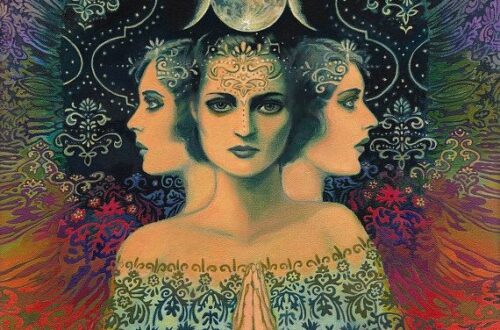Book Review – Bogowie: A Study of Eastern Europe’s Ancient Gods by T.D. Kokoszka
Teachings of the Mythic Past – Book Review on Bogowie: A Study of Eastern Europe’s Ancient Gods by T.D. Kokoszka
If you’re looking for an easy read or beginner’s book on Slavic myth, folklore, and Paganism you might want to look elsewhere. This book features tons of advanced information on traditional Slavic Pagan beliefs. Chapter 6 of Bogowie is called Advanced Concepts in Indo-European Mythology, but I think this would not have been such a bad way to describe the book itself!
T.D. Kokoszka focuses greatly on Slavic mythology and folklore in this very in-depth study. But with that being said, the book is certainly not for beginners who are new to Paganism itself or Slavic paganism in general. However, if you are more familiar with the Slavic deities, magic, and mythology, this is a great book for your collection and reference information – Especially if you are prone to well-researched writing and digging very deep on a wide variety of topics that have to do with Slavic paganism, and the gods of the ancient Slavs.
The first chapter and the introduction are quite in-depth. The book contains a wealth of credible material and cites a large number of sources. The intriguing thing about this book is that it functions like a textbook because of its size and content. The reader is left to decide if this is a positive or negative thing. People unfamiliar with the topic may find it challenging to make sense of due to the sheer volume of information it contains.
I thought it was great that Marija Gimbutas got the recognition she deserved in this book. The Roots of Slavic Magic Book 1 author, Patricia Robin Woodruff is the first person listed at the beginning of the book to suggest this book to anyone seeking a connection to their Slavic heritage, spirituality, or folklore which I thought was a good sign. In my opinion, the real enjoyment started once I finished the introduction and the first chapter.
The author mentioned, “Marija Gimbutas wrote a lot about what she saw as “Old European” beliefs hidden within paganism – that is, relics of the old matriarchal culture which she thought the Indo-European nomads had replaced. While she may have been more liberal than most in this pursuit, I don’t think she was altogether wrong that some traditions can be traced back to the Neolithic.”

This was an excellent mention and the author shares different perspectives on myth and folklore that can help the world understand Slavic Paganism much better. Through his journey, he is in return sharing with the world.
Chapter 2 is a combination of Baba Yaga and the Great Mother Mokosh. As the author mentions, “folklore is the most significant medium in which Slavic paganism has survived”, and this is the reason for the author to include folktale retellings and stories throughout his book which I loved. I appreciate the author going into detail about the Fairy tale classification system and such, but I don’t think mentioning this or Celtic goddesses before mentioning Baba Yaga and Mokosh was the best approach, especially for people new to this topic who are simply starting.

It’s great that we can compare mythologies and folklore with other parts of the world, but if your chapter title is Baba Yaga and Mokosh, I expect to learn about them first. And then learn about how the other deities and folktales connect to these two extremely important figures in Slavic spirituality. What is great about this book is the fact that the author is making great connections between deities like Baba Yaga, Frau Holle, and Perchta. These are figures which appear all over Europe and are certainly related.
This book is very well suited for scholarly-level reading and researching. The amount of work it took to put together this wonderful and highly researched book must have taken hours upon hours and will be appreciated by many. In reality, this book takes you all over the world and not just to the Slavic countries. The book is a treat, but beware, as it is not something you can finish in one night. The information here is valuable and intense and should be cherished and you should take the time to process it all.
The studies and history were enthralling to me. Concerning the neglect or omission of Slavic culture, the author raised numerous valid concerns. I found it interesting how there were so many references to different languages and folklore. From deities to folk magic, Bogowie provides an academically sound exploration of Slavic paganism, which is an intriguing topic in and of itself.

Despite his Polish and Jewish ancestry, Kokoszka spent his childhood in Texas. His family’s Eastern European origins were obvious to him, but he had a hard time learning more about them. But until he was a teenager, he had no idea that the ancient Slavs were the ancestors of the languages spoken today in Russia, Ukraine, Poland, Serbian, Bulgarian, Slovene, and Czech. It didn’t take long for him to figure out that this was a cultural family that was severely underrepresented in mainstream Western thought and literature. This wonderful book offers new interpretations based on hitherto discovered sources, making it one of the most thorough scientific reconstructions of Slavic paganism.
Included in these updated materials is an outline of Slavic folklore and an analysis of several Slavic folktales by Kokoszka, who often claims that the stories are mythological and incredibly ancient and draws parallels to the cultures of Ossetia and Mordvin. Readers will get a better understanding of European folktales, specifically Slavic ones after reading this book.
**
About the Author:

Kimberly Anne is a USA freelance writer and Administrative Secretary of Art and Music at a college near her hometown. Originally from Chicago, Illinois, she holds a bachelor’s degree with honors in Creative Writing and English Literature and is also a member of Sigma Tau Delta. She is currently working on her Masters in Library and Information Science degree.
After devoting a decade to the personal study of global mythology and folklore, she began writing about them. She focuses primarily on Nordic, Germanic, and Slavic pre-Christian beliefs. Kimberly has worked with various clients on freelance work including Patricia Robin Woodruff, PhD. MDiv and the YouTube channel Mythology Unleashed. She is a polytheist with animist beliefs who loves to talk about it all! You can find her in the book stacks of the library, in a forest with Landvættir or at www.kimberlyanneinc.com




